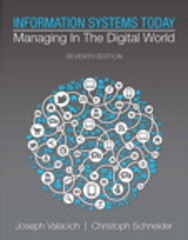Question
Answer the following questions. Short answer responses, two or three paragraphs each 1. Define artificial intelligence and provide examples of AI applications in different fields.
Answer the following questions. Short answer responses, two or three paragraphs each
1. Define artificial intelligence and provide examples of AI applications in different fields.
2. Explain the Turing Test and its significance in evaluating AI capabilities.
3. Differentiate between narrow (weak) AI and general (strong) AI, with examples of each.
4. Describe the key components of a neural network.
5. Discuss the importance of data preprocessing in machine learning and give examples of techniques used.
6. Explain the bias-variance trade-off in the context of machine learning model performance. Provide strategies to mitigate high bias or high variance.
7. Compare and contrast supervised, unsupervised, and reinforcement learning, providing examples of each.
8. Discuss overfitting and underfitting in machine learning. Describe regularization techniques used to address these issues.
9. Describe the vanishing gradient problem in deep neural networks and how it can be mitigated.
10. Compare recurrent neural networks (RNNs) and transformers. Discuss the advantages of using transformers for NLP tasks. 11. Explain the concept of transfer learning in deep learning and provide examples of pre-trained models.
12. Describe the purpose of word embeddings.
13. Explain the tasks of named entity recognition (NER) and sentiment analysis in NLP.
14. Discuss the ethical challenges associated with bias in AI systems. Provide examples of how bias can manifest in different AI applications.
15. Explain the concept of explainable AI (XAI) and why it is important in real-world applications.
16. Consider the potential impact of AI on the job market. Discuss strategies that society can adopt to address potential job displacement.
17. Analyze a real-world case where AI has been applied to solve a complex problem (e.g., healthcare, finance, autonomous vehicles). Discuss the benefits and challenges of the AI solution.
18. Compare and contrast traditional rule-based systems with machine learning-based approaches. Provide examples of tasks where each approach excels.
19. Describe how AI techniques can be used for recommendation systems. Provide an example of a recommendation system and its application.
20. Do you think SCSU will ever have an AI Otis?
Step by Step Solution
There are 3 Steps involved in it
Step: 1

Get Instant Access to Expert-Tailored Solutions
See step-by-step solutions with expert insights and AI powered tools for academic success
Step: 2

Step: 3

Ace Your Homework with AI
Get the answers you need in no time with our AI-driven, step-by-step assistance
Get Started


